Select units of measurement for the temperature and rainfall tables (metric or imperial).
Average weather, temperature, rainfall, sunshine hours
In Honshu, the climate is
humid temperate in the northernmost part, with cold, snowy winters and warm, rainy summers, while it is
humid subtropical in the central-southern part, where the winters are milder, while the summers are decidedly muggy, as well as rainy.
Like the rest of Japan, the island is affected by the
monsoon circulation: in winter, cold currents from the northwest prevail, while in summer, warm and humid currents of tropical origin prevail.
Honshu is the largest island in Japan, it is home to the capital, Tokyo, and extends between the Sea of Japan to the west and the Pacific Ocean to the east, between 33 and 41 degrees north latitude.
The interior is occupied by
mountains, which influence the climate, especially in winter, when the side exposed to cold winds from the continent receives rain and snow, while the one exposed to the south-east is drier and sunnier.
In these mountains, there are famous
winter sports resorts, such as Morioka, in the far north, and Nagano, northwest of Tokyo, which hosted the 1998 Winter Olympics. There is usually snow for skiing from December to March, but also in April in the north and in the higher mountains.
In
winter, the average temperature in January is -1 °C (30 °F) at the northern tip (see Aomori), and gradually increases southwards, reaching 6 °C (43 °F) in Tokyo and 7 °C (44.5 °F) in the southernmost part.
During
cold waves, the temperature can drop below -15 °C (5 °F) in the northern part and below -20 °C (-4 °F) in the mountainous interior, while the records are around -5 °C (23 °F) on the southern coast.
In
summer, the average for August, the warmest month, ranges from 24 °C (75 °F) at the northern tip (see Aomori), to 28 °C (82.5 °F) in Tokyo, to almost 30 °C (86 °F) in the hottest area, facing the Seto Inland Sea (see Osaka).
During
heat waves, the temperature can reach 36/37 °C (97/99 °F) in the north, while it can reach 38/40 °C (100/104 °F) in the large cities of the south.
Precipitation is abundant, ranging from 1,150 millimeters (45 inches) per year in the most sheltered area of the Seto Inland Sea (see Okayama), to 1,300 mm (51 in) in Osaka and Kobe and in the north, to 1,600 mm (63 in) in Tokyo, to 2,500 mm (98 in) in the rainiest area of the northwest side (see Kanazawa), and up to almost 4 meters (157 in) per year in Owase, on the south coast, one of the rainiest cities in the world outside the Tropics.
Snowfall is abundant in the north, on the northwest side and in the mountains, while it is rare in Tokyo and on the southern side.
Aomori
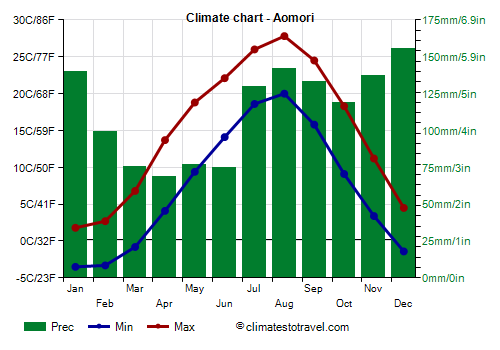
In the northern tip of the island, in the region called
Tohoku, the winter is still very cold, with averages slightly below freezing in January and February. Epic snowfalls occur on the north and north-west slopes that are directly exposed to the prevailing wind. Here are the average temperatures of Aomori.
Aomori - Average temperatures (1991-2020) |
| Month | Min | Max | Mean |
|---|
| January | -3.5 | 1.8 | -0.8 |
|---|
| February | -3.3 | 2.7 | -0.3 |
|---|
| March | -0.8 | 6.8 | 3 |
|---|
| April | 4.1 | 13.7 | 8.9 |
|---|
| May | 9.4 | 18.8 | 14.1 |
|---|
| June | 14.1 | 22.1 | 18.1 |
|---|
| July | 18.6 | 26 | 22.3 |
|---|
| August | 20 | 27.8 | 23.9 |
|---|
| September | 15.8 | 24.5 | 20.2 |
|---|
| October | 9.1 | 18.3 | 13.7 |
|---|
| November | 3.4 | 11.2 | 7.3 |
|---|
| December | -1.4 | 4.5 | 1.6 |
|---|
| Year | 7.2 | 14.9 | 11 |
|---|
The yearly precipitation in Aomori is around 1,350 mm (53 inches) per year. Snowfall, which normally occurs from November to March, amounts to as much as 565 cm (223 in) per year, making it one of the snowiest plain cities in the world.
Aomori - Average precipitation| Month | Days |
|---|
| January | 140 | 22 |
|---|
| February | 99 | 18 |
|---|
| March | 75 | 14 |
|---|
| April | 69 | 11 |
|---|
| May | 77 | 10 |
|---|
| June | 75 | 8 |
|---|
| July | 130 | 9 |
|---|
| August | 142 | 10 |
|---|
| September | 133 | 10 |
|---|
| October | 119 | 13 |
|---|
| November | 137 | 17 |
|---|
| December | 155 | 21 |
|---|
| Year | 1350 | 162 |
|---|
The sun in Aomori is rarely seen in winter. The relatively sunnier season is spring and in summer the sun does not shine very often, both because of the monsoon and because the clash between sea currents can give rise to fog.
Aomori - Sunshine hours| Month | Average | Total |
|---|
| January | 1.5 | 50 |
|---|
| February | 2.5 | 75 |
|---|
| March | 4 | 125 |
|---|
| April | 6 | 180 |
|---|
| May | 6.5 | 200 |
|---|
| June | 6 | 180 |
|---|
| July | 5 | 160 |
|---|
| August | 5.5 | 180 |
|---|
| September | 5.5 | 160 |
|---|
| October | 4.5 | 145 |
|---|
| November | 3 | 85 |
|---|
| December | 1.5 | 50 |
|---|
| Year | 4.4 | 1590 |
|---|
Niigata
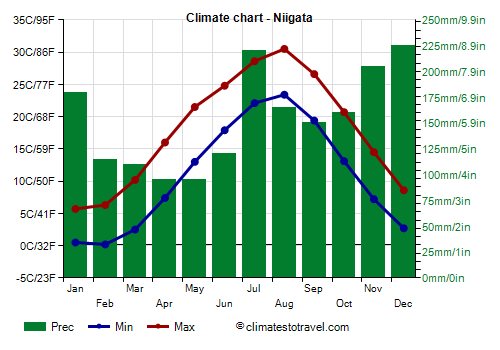
More to the south, in the north-central part of the island (see
Niigata), the average rises to 2/3 °C (36/37 °F). However, winter is still cold enough to cause
frequent snowfalls on the western side, which in this season is definitely more humid than the eastern one. This is because, ad mentioned, the prevailing winds coming from Siberia, initially dry, pick up moisture from the Sea of Japan (called East Sea by the Koreans) and release it on the north-west side. The other side is instead protected by the mountain ranges that cross the island like a kind of spine.
Niigata - Average temperatures (1991-2020) |
| Month | Min | Max | Mean |
|---|
| January | 0.5 | 5.7 | 3.1 |
|---|
| February | 0.2 | 6.3 | 3.2 |
|---|
| March | 2.5 | 10.2 | 6.4 |
|---|
| April | 7.4 | 16 | 11.7 |
|---|
| May | 13 | 21.5 | 17.2 |
|---|
| June | 17.9 | 24.8 | 21.4 |
|---|
| July | 22.1 | 28.6 | 25.4 |
|---|
| August | 23.4 | 30.5 | 27 |
|---|
| September | 19.4 | 26.6 | 23 |
|---|
| October | 13.1 | 20.7 | 16.9 |
|---|
| November | 7.2 | 14.5 | 10.8 |
|---|
| December | 2.7 | 8.6 | 5.6 |
|---|
| Year | 10.8 | 17.9 | 14.35 |
|---|
On the western side, there is not much sun. It is seldom seen in winter, while it goes not much better during the other seasons. In Niigata, there are about 1,600 hours of sunshine per year.
Niigata - Sunshine hours| Month | Average | Total |
|---|
| January | 2 | 55 |
|---|
| February | 2.5 | 75 |
|---|
| March | 4.5 | 135 |
|---|
| April | 6 | 180 |
|---|
| May | 6.5 | 205 |
|---|
| June | 6 | 180 |
|---|
| July | 5 | 160 |
|---|
| August | 6.5 | 205 |
|---|
| September | 5 | 155 |
|---|
| October | 4.5 | 140 |
|---|
| November | 3 | 90 |
|---|
| December | 2 | 65 |
|---|
| Year | 4.5 | 1645 |
|---|
Precipitation in Niigata is abundant: up to 1,850 mm (72.5 in) per year. In winter, with the temperature slightly above freezing and the wind coming from the sea, it rains and snows almost every day.
Niigata - Average precipitation| Month | Days |
|---|
| January | 180 | 23 |
|---|
| February | 115 | 19 |
|---|
| March | 110 | 17 |
|---|
| April | 95 | 13 |
|---|
| May | 95 | 11 |
|---|
| June | 120 | 11 |
|---|
| July | 220 | 14 |
|---|
| August | 165 | 11 |
|---|
| September | 150 | 14 |
|---|
| October | 160 | 15 |
|---|
| November | 205 | 19 |
|---|
| December | 225 | 24 |
|---|
| Year | 1845 | 191 |
|---|
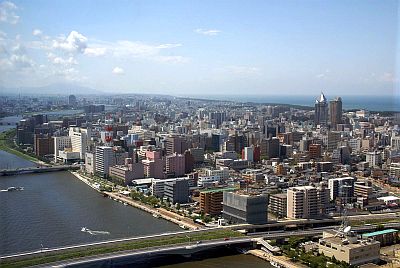
While on the western side the winter is very annoying, with leaden skies, rain and snow falling almost daily, and with possible sea storms, the
eastern side is protected by mountain ranges, so it experiences a fair number of sunny days (see
Sendai, which is at the same latitude as Niigata but on the east coast).
The phenomenon also occurs at lower latitudes (see
Kanazawa, on the west coast, and
Mito, on the east coast).
Tokyo
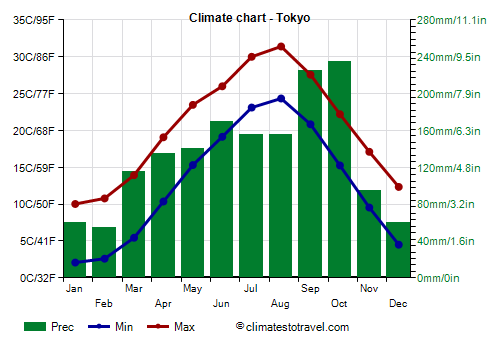
Further south, the island of Honshu bends to the left, so the Pacific coast is exposed directly to the south. Here we find the
main cities of Japan.
In
Tokyo, the capital, the average temperature ranges from 6 °C (43 °F) in January to 28 °C in August. So the summer is hot, but above all, it's decidedly muggy.
Tokyo - Average temperatures (1991-2020) |
| Month | Min | Max | Mean |
|---|
| January | 2.1 | 10 | 6.1 |
|---|
| February | 2.6 | 10.8 | 6.7 |
|---|
| March | 5.4 | 13.9 | 9.7 |
|---|
| April | 10.4 | 19.1 | 14.7 |
|---|
| May | 15.3 | 23.5 | 19.4 |
|---|
| June | 19.2 | 26 | 22.6 |
|---|
| July | 23.1 | 30 | 26.6 |
|---|
| August | 24.3 | 31.4 | 27.9 |
|---|
| September | 20.8 | 27.6 | 24.2 |
|---|
| October | 15.3 | 22.2 | 18.7 |
|---|
| November | 9.6 | 17.1 | 13.3 |
|---|
| December | 4.5 | 12.4 | 8.4 |
|---|
| Year | 12.8 | 20.4 | 16.55 |
|---|
Winter in Tokyo and Osaka is the sunniest and driest season of the year; the temperatures are quite cold though bearable, with highs around 10 °C (50 °F) and lows just above freezing.
On the eastern side,
the winter is the sunniest season, at least as a percentage (considering that the days are shorter), while in the other seasons, more cloudy and rainy, the amount of sunshine is not high.
In Tokyo, there are a bit more than 1,900 hours of sunshine per year.
Tokyo - Sunshine hours| Month | Average | Total |
|---|
| January | 6 | 195 |
|---|
| February | 6 | 170 |
|---|
| March | 5.5 | 175 |
|---|
| April | 6 | 180 |
|---|
| May | 6 | 180 |
|---|
| June | 4 | 125 |
|---|
| July | 5 | 150 |
|---|
| August | 5.5 | 175 |
|---|
| September | 4 | 125 |
|---|
| October | 4 | 130 |
|---|
| November | 5 | 150 |
|---|
| December | 5.5 | 175 |
|---|
| Year | 5.3 | 1930 |
|---|
Snowfalls in Tokyo are quite rare, and are even more rare in the conurbation that includes
Osaka,
Kobe and
Kyoto, and in general along the south-facing coast of the Seto Inland Sea, which is protected by the mountains.
On average, 1,600 mm (63 in) of rain fall per year. As we mentioned, since it lies on the south-eastern side, it is protected from the winter monsoon, so the winter here is definitely the driest season. In the other seasons it rains a lot, with a maximum in September and October.
Tokyo - Average precipitation| Month | Days |
|---|
| January | 60 | 5 |
|---|
| February | 55 | 6 |
|---|
| March | 115 | 10 |
|---|
| April | 135 | 11 |
|---|
| May | 140 | 11 |
|---|
| June | 170 | 13 |
|---|
| July | 155 | 12 |
|---|
| August | 155 | 9 |
|---|
| September | 225 | 12 |
|---|
| October | 235 | 12 |
|---|
| November | 95 | 8 |
|---|
| December | 60 | 6 |
|---|
| Year | 1600 | 116 |
|---|
During Tokyo’s winter, the sea is much warmer than in the north, becoming warm enough for swimming from July to October, and a bit cool but still acceptable in June.
Tokyo - Sea temperature| Month |
|---|
| January | 16.5 |
|---|
| February | 15.5 |
|---|
| March | 16 |
|---|
| April | 17.5 |
|---|
| May | 20 |
|---|
| June | 22 |
|---|
| July | 24.5 |
|---|
| August | 26.5 |
|---|
| September | 25.5 |
|---|
| October | 23 |
|---|
| November | 21"> |
|---|
| December | 18.5 |
|---|
| Year | 20.6 |
|---|
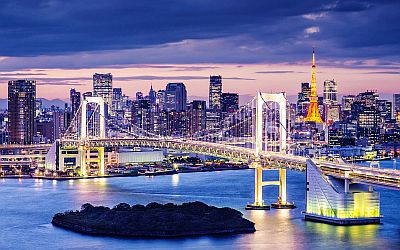
Mountains
In the
mountainous areas, culminating in Mount Fuji, 3,778 meters (12,395 feet) high, the winter temperatures are naturally lower, and snow is abundant, especially on the western slopes.
For example, in
Karuizawa, a resort town located at 1,000 meters (3,300 ft) of altitude in the Nagano prefecture, northwest of Tokyo, where the capital's inhabitants flock during summer to escape the heat, the average temperature ranges from -2.9 °C (26.8 °F) in January to 21.7 °C (71 °F) in August.
Karuizawa - Average temperatures (1991-2020) |
| Month | Min | Max | Mean |
|---|
| January | -8.2 | 2.3 | -2.9 |
|---|
| February | -8 | 3.5 | -2.2 |
|---|
| March | -4.5 | 7.8 | 1.6 |
|---|
| April | 0.6 | 14.3 | 7.4 |
|---|
| May | 6.3 | 19.2 | 12.8 |
|---|
| June | 11.8 | 21.5 | 16.6 |
|---|
| July | 16.4 | 25.3 | 20.8 |
|---|
| August | 17.1 | 26.3 | 21.7 |
|---|
| September | 13 | 21.7 | 17.4 |
|---|
| October | 6.3 | 16.2 | 11.2 |
|---|
| November | -0.2 | 11.2 | 5.5 |
|---|
| December | -5.3 | 5.3 | 0 |
|---|
| Year | 3.8 | 14.6 | 9.2 |
|---|
In some mountainous areas, such as in Mount Zao, a curious phenomenon occurs, known as "snow monsters", whereby the moisture carried by the wind is deposited as ice on the trees, upon which large quantities of snow then fall.
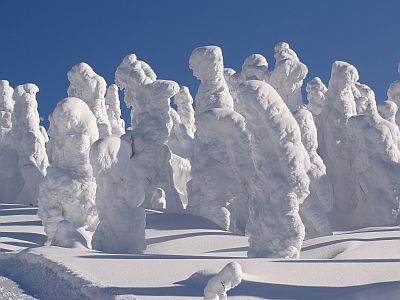
Typhoons
Like the rest of Japan, the island of Honshu can be hit by
typhoons, the tropical cyclones of the western Pacific.
Typically, typhoons occur from June to October, however, they are more frequent
from August to early October; the strongest ones have occurred in September.
The area most affected is the southern coast, directly exposed to southerly winds and storm surges from the Pacific.
Cherry blossoms
The cherry blossoming (
Sakura)
begins in late March in the south and in early April in the north. About a week passes between the start and peak bloom.
For example, in 2025, in Tokyo, the start of the flowering is expected for March 24, and the peak for the 31st, while in Sendai, the start is expected for April 7 and the peak for the 13th.
The date of the bloom can vary by a few days, or even a week, earlier or later, depending on the year.